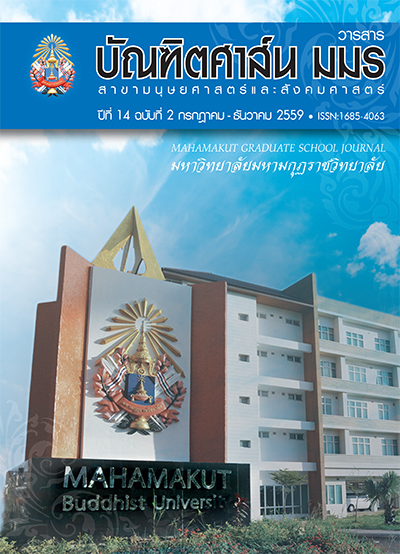ศึกษาแนวทางการปฏิบัติวิปัสสนาภาวนาในอนาถปิณฑิโกวาทสูตร
คำสำคัญ:
อนาถปิณฑิโกวาทสูตร, การปฏิบัติวิปัสสนาภาวนาบทคัดย่อ
การศึกษานี้มีวัตถุประสงค์เพื่อ 1) ศึกษา เนื้อหาหลักธรรมในอนาถปิณฑิโกวาทสูตร 2) ศึกษา แนวทางการปฏิบัติวิปัสสนาภาวนาในอนาถปิณฑิโก วาทสูตร โดยเป็นการวิจัยเชิงคุณภาพภาคเอกสาร (Qualitative Research) จากการศึกษาพบว่า
1.อนาถปิณฑิโกวาทสูตร มีเนื้อหาโครงสร้าง บรรยายถึงบุคคล และหลักธรรมว่าด้วยการคลาย ความยึดมั่นในอายตนะภายใน 6 อายตนะภายนอก 6 วิญญาณ 6 สัมผัส 6 เวทนา 6 ธาตุ 6 ขันธ์ 5 อรูปฌาน 4 โลกนี้ โลกหน้า และอารมณ์ที่รับรู้ทาง อายตนะ 6
2.หลักการปฏิบัติวิปัสสนาภาวนาในพระสูตรนี้ ว่าโดยรวมแล้วสรุปลงในสติปัฏฐาน 4 คือ การใช้สติ เป็นฐานในการพิจารณาไปในกาย เวทนา จิตและ ธรรม โดยมี วิปัสสนาภูมิ 6 หรือ รูปกับนาม เป็น อารมณ์ของวิปัสสนา ประกอบกับโพธิปักขิยธรรม 37 ซึ่งมีแนวทางการปฏิบัติวิปัสสนาภาวนา โดย พิจารณาผัสสะที่กระทบกับอายตนะภายใน และเป็น เหตุให้เกิดทุกข์ เช่นตาเห็นรูป เกิดจักขุวิญญาณ ก่อ ให้เกิดความรู้สึกคือเวทนาสุข ทุกข์ หรือเฉยๆ สิ่งที่ กระทบเป็นธาตุที่ประกอบ เมื่อมีความรู้สึกในธาตุ เกิดอุปาทานความยึดมั่นถือมั่น เมื่อผู้ปฏิบัติเห็นชอบตามความเป็นจริงว่า ไม่ว่าจะยืน เดิน นั่ง นอน และทำอากัปกิริยาใดๆ มีเพียงธาตุ 4 ที่มาประชุม กัน โดยปราศจากความเป็นตัวตน เรา เขา ผู้ปฏิบัติ ย่อมไม่ติดใจธาตุใดธาตุหนึ่งว่า เป็นเรา เป็นของเรา ย่อมปล่อยวางความยึดมั่นถือมั่นอย่างเด็ดขาด
เอกสารอ้างอิง
พระธรรมกิตติวงศ์ (ทองดี สุรเตโช), พจนานุกรมเพื่อการศึกษาพุทธศาสน์ ชุดศัพท์วิเคราะห์,กรุงเทพมหานคร: โรง พิมพ์เลี่ยงเซียง, 2558.
พระธรรมธีรราชมหามุนี (โชดก ญาณสิทฺธิ ป.ธ. 9). วิปัสสนากรรมฐาน. งานออกเมรุพระราชทานเพลิงศพ พระภัท ทันตะ อาสภมหาเถร ธัมมาจริยะ
อัคคมหากัมมัฏฐานาจริยะ. พิมพ์ครั้งที่ 3. กรุงเทพมหานคร: บริษัท ประยูรวงศ์พริ้นติ้ง จํากัด, 2554.
พระพรหมคุณาภรณ์ (ป.อ.ปยุตฺโต).พุทธธรรม ฉบับปรับขยาย. พิมพ์ครั้งที่ 35. กรุงเทพมหานคร: สํานักพิมพ์ผลิธัมม์, 2555.
พระโสภณมหาเถระ (มหาสีสยาดอ). มหาสติปัฏฐานสูตรทางสู่พระนิพพาน. พระพรหมโมลี (สมศักดิ์ อุปสโมป.ธ. 9,M.A.,Ph.D.) ตรวจชําระ. แปลและเรียบเรียงโดย พระคันธสาราภิวงศ์. กรุงเทพมหานคร: ห้างหุ้นส่วนจํากัด ไทยรายวันการ พิมพ์, 2549.
______.วิปัสสนานัย เล่ม 1. พระพรหมโมลี ( สมศักดิ์ อุปสโมป.ธ. 9, M.A., Ph.D. ) ตรวจชําระ. พระคันธสาราภิวงศ์ แปลและเรียบเรียง. กรุงเทพมหานคร: ประยูรสาส์นไทยการ พิมพ์, 2557.
มหาจุฬาลงกรณราชวิทยาลัย. พระไตรปิฎกภาษาบาลี ฉบับมหาจุฬาเตปิฏกํ 25๐๐. กรุงเทพมหานคร: โรงพิมพ์มหา จุฬาลงกรณราชวิทยาลัย, 2535.
มหามกุฏราชวิทยาลัย. พระไตรปิฎกพร้อมอรรถกถา แปล ชุด 91 เล่ม. กรุงเทพมหานคร: โรงพิมพ์ มหามกุฏราชวิทยาลัย, 2556.
________. ปกรณวิเสสภาษาบาลี ฉบับมหาจุฬาปกรณวิเสโส. กรุงเทพมหานคร: โรงพิมพ์ วิญญาณ, 2539
ดาวน์โหลด
เผยแพร่แล้ว
รูปแบบการอ้างอิง
ฉบับ
ประเภทบทความ
สัญญาอนุญาต
บทความวิชาการและบทความวิจัยในวารสารฉบับนี้ถือเป็นความรับผิดชอบของผู้เขียนเท่านั้น บทความที่ได้รับการตีพิมพ์ในวารสารบัณฑิตศาส์น ถือเป็นลิขสิทธิ์ของมหาวิทยาลัยมหามกุฏราชวิทยาลัย ตามพระราชบัญญัติลิขสิทธิ์



